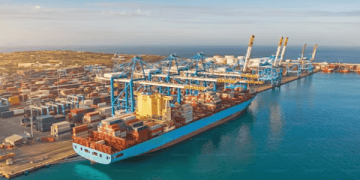Economic and trade relations between Vietnam and China have seen significant growth in recent years, with bilateral trade exceeding 260 billion USD in 2024, as reported by China’s Ministry of Commerce’s commercial news website, comnews.cn.
According to China’s General Administration of Customs, China remains Vietnam’s largest trade partner for over 20 years, while the General Department of Vietnam Customs estimates that bilateral trade accounted for nearly one-third of Vietnam’s total trade in 2024.
Strong Growth in Trade and Investment
Comnews.cn reports that trade between the two nations grew rapidly in 2024, reaching 260.65 billion USD, an increase of 13.5% from the previous year. Of this, China’s exports to Vietnam amounted to 161.89 billion USD, a 17.7% year-on-year increase, while Vietnam’s exports to China totaled 98.76 billion USD, rising 7.2%. China mainly exports machinery, textiles, and raw materials to Vietnam, while it imports agricultural products and minerals from Vietnam.
China is also Vietnam’s top agricultural export market. Between January and November 2024, Vietnam exported 4.1 billion USD worth of fruits and vegetables to China, and 1.4 billion USD in aquatic products, marking increases of 28.7% and 23.2%, respectively, compared to the same period in 2023. Vietnamese durian, a popular fruit among Chinese consumers, saw substantial growth in exports, with 692,500 tonnes valued at 2.7 billion USD shipped to China in the first 10 months of 2024, following the approval of export licenses in 2022.
In terms of investment, Vietnam remains a key destination for Chinese investors, with 1.97 billion USD invested between January and August 2024. China’s total direct investment in Vietnam reached 4.47 billion USD in 2023, bringing the cumulative figure to 27.8 billion USD by year-end. Chinese investments have funded infrastructure projects like the Hanoi Metro Line No. 2, as well as solar and wind energy initiatives, showcasing growing green economic cooperation between the two countries.
Infrastructure Development and Future Prospects
A major step forward came in December 2024 when Vietnam and China signed an agreement on a cross-border standard-gauge railway project, which will include three major railway lines: Lao Cai – Hanoi – Hai Phong, Lang Son – Hanoi, and Mong Cai – Ha Long – Hai Phong. This development is expected to boost cross-border trade and economic collaboration.
Experts see vast potential for further economic cooperation between the two nations. Yuan Bo, Director of the Institute of Asian Studies at the Chinese Academy of International Trade and Economic Cooperation, emphasized that both countries are committed to advancing high-quality free trade cooperation under frameworks like the China-ASEAN Free Trade Area and the Regional Comprehensive Economic Partnership (RCEP).
Looking forward, the upgrade of the China-ASEAN Free Trade Area and RCEP, alongside the development of cross-border infrastructure, is expected to further facilitate trade and investment liberalization. The two countries are also anticipated to focus on emerging sectors such as the digital economy, green economy, and supply chain connectivity. As these sectors grow, improved soft connectivity in areas like markets, rules, and standards will play a crucial role in enhancing bilateral cooperation.
Vietnam’s digital economy is rapidly expanding, with reports showing a 16% compound annual growth rate in 2024. This growth, fueled by e-commerce and online tourism, offers opportunities for increased collaboration in areas like digital transformation, smart cities, and artificial intelligence.
Vietnam is also focusing on developing a green economy, with a national green growth strategy in place. Cooperation in clean energy, new energy vehicles, and green finance is expected to expand, driven by initiatives within the China-ASEAN Free Trade Area 3.0.
Discover supply chain news insights on The Supply Chain Report. Enhance your international trade knowledge at ADAMftd.com with free tools.
#TradeRelations #VietnamChinaCooperation #DigitalEconomy #GreenEconomy #BilateralTrade

















